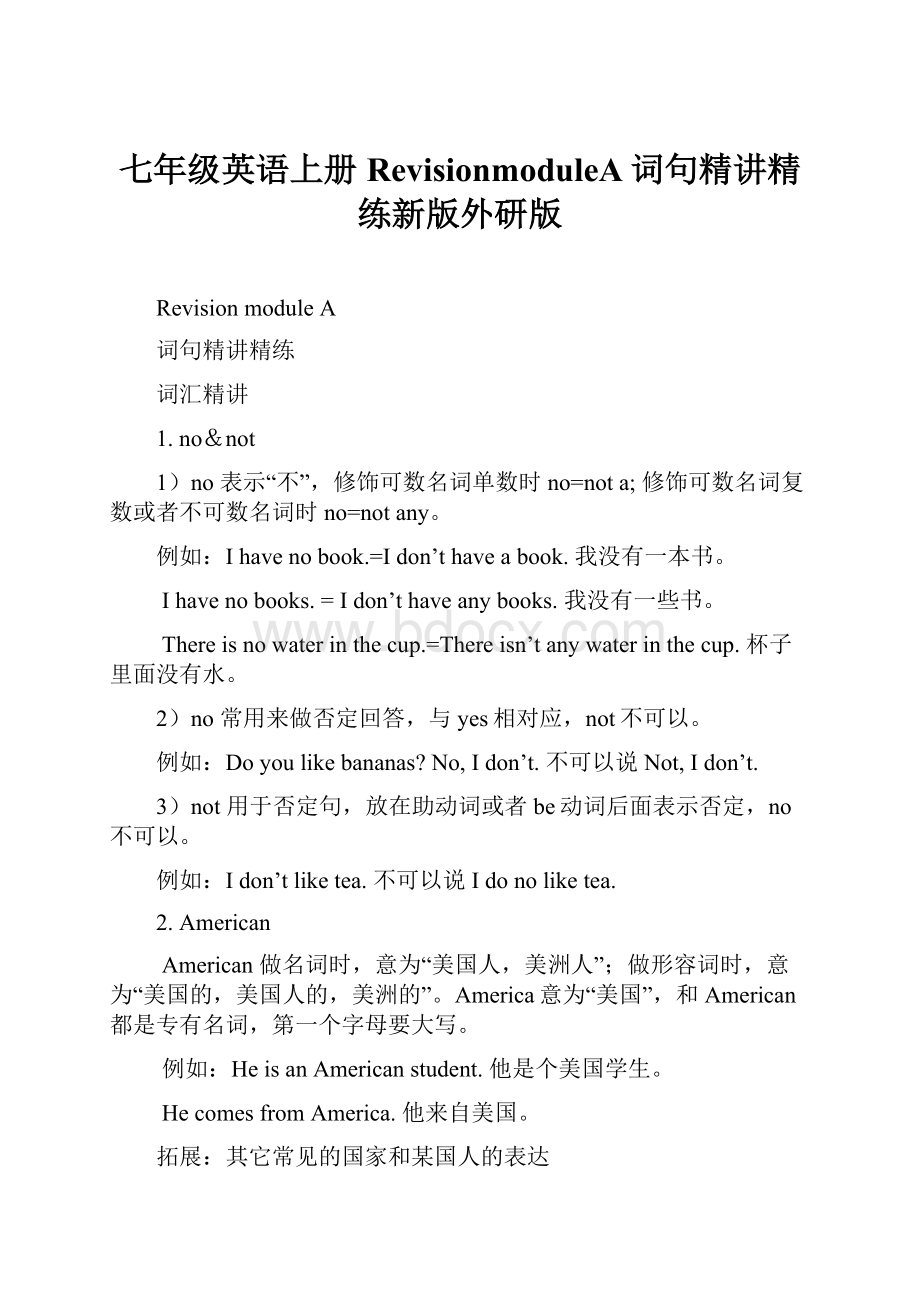七年级英语上册RevisionmoduleA词句精讲精练新版外研版.docx
《七年级英语上册RevisionmoduleA词句精讲精练新版外研版.docx》由会员分享,可在线阅读,更多相关《七年级英语上册RevisionmoduleA词句精讲精练新版外研版.docx(18页珍藏版)》请在冰豆网上搜索。

七年级英语上册RevisionmoduleA词句精讲精练新版外研版
RevisionmoduleA
词句精讲精练
词汇精讲
1.no&not
1)no表示“不”,修饰可数名词单数时no=nota;修饰可数名词复数或者不可数名词时no=notany。
例如:
Ihavenobook.=Idon’thaveabook.我没有一本书。
Ihavenobooks.=Idon’thaveanybooks.我没有一些书。
Thereisnowaterinthecup.=Thereisn’tanywaterinthecup.杯子里面没有水。
2)no常用来做否定回答,与yes相对应,not不可以。
例如:
Doyoulikebananas?
No,Idon’t.不可以说Not,Idon’t.
3)not用于否定句,放在助动词或者be动词后面表示否定,no不可以。
例如:
Idon’tliketea.不可以说Idonoliketea.
2.American
American做名词时,意为“美国人,美洲人”;做形容词时,意为“美国的,美国人的,美洲的”。
America意为“美国”,和American都是专有名词,第一个字母要大写。
例如:
HeisanAmericanstudent.他是个美国学生。
HecomesfromAmerica.他来自美国。
拓展:
其它常见的国家和某国人的表达
国家
居民
语言
China中国
Chinese中国人
Chinese汉语
America美国
American美国人
English英语
England英国
Englishman英国人
English英语
Japan日本
Japanese日本人
Japanese日语
3.be
be动词包括am,is,are。
在句子中使用时,要和主语的单复数或者人称相配合。
am用在I的后面;is用在第三人称单数(she,he,it或者单数名词)的后面;其余的人称用are。
例如:
Iamateacher.我是个老师。
Sheisaworker.她是个工人。
Theyaremyteachers.他们是我的老师。
4.these&those
these是this的复数形式,意为“这些”。
those是that的复数形式,意为“那些”。
this,these,that,those这四个词称为指示代词,用来指示或标识人或事物。
this与that后接单数名词,是单数指示代词;those与these后接复数名词,是复数指示代词。
通常谈论离自己近的人或物时用this/these;谈论离自己远的人或物时用that/those。
例如:
Thisisabook.这是一本书。
ThosegirlsareinClass3.那些女孩在三班。
5.it’s&its
it’s=itis意为“它是”。
it是代词,意为“它”,表示第三人称单数。
its意为“它的”,后面需要加名词。
例如:
Itisabook.=It’sabook.它是一本书。
Ihaveabook.Itspictureisbeautiful.我有一本书,它的图片很漂亮。
6.howmany&howmuch
1)howmuch和howmany是同义词组,意为“多少”。
howmany用来提问可数名词的数量,后跟可数名词的复数。
例如:
Howmanybooksarethereinyourschoollibrary?
你们学校图书馆有多少本书?
2)howmuch用来提问不可数名词的量。
例如:
—Howmuchwateristhereinthebottle?
瓶子里面有多少水?
—Onlyalittle.仅一点。
3)howmuch既可以用来询问不可数名词量,也可以用来询问物体的价钱。
例如:
—Howmuchisthisbook?
这本书多少钱?
—20yuan.20元。
7.some&any
some和any意思都是“一些”,既可以修饰可数名词,也可以修饰不可数名词。
但用法有些不同。
1)some一般用在肯定句,any常用于否定句或疑问句。
例如:
Isthereanyfoodonthedesk?
桌上有食物吗?
Therearen’tanystudentsintheclassroom.教室里没有学生。
Therearesomebirdsinthetree.树上有些鸟。
2)在表示委婉的请求或希望对方给予肯定回答的一般疑问句中用some。
例如:
Couldyoupleasebringsomethingstoschool?
请你把一些东西带到学校好吗?
3)any可以用于肯定句中表示“任何”,指三者以上任何一个,后接可数名词单数或复数形式。
例如:
Helikesanybookinhisfather’sroom.
他喜欢他爸爸房间里的任何一本书。
Weknowanyofthem.我认识他们当中的任何一个。
8.lotsof
lotsof的意思是“大量的、许多的”,和alotof是同义词短语。
lotsof既可以修饰可数名词的复数形式,相当于many;也可以修饰不可数名词,相当于much。
例如:
lotsoftime=muchtime(大量的时间)lotsofchicken=muchchicken(许多鸡肉)
lotsofapples=manyapples(大量的苹果)
9.stayhealthy
1)stayhealthy”意为“保持健康”。
healthy是形容词,意为“健康的”,“healthyfood”意为“健康食品”。
healthy的名词为health,副词为healthily,反义词为unhealthy。
例如:
Theoldmanlookshealthy.这个老人看起来很健康。
Healthyfoodisgoodforourhealth.健康食品对我们的健康有益。
2)stay在此做系动词,后跟形容词作表语,意为“保持(某种状态)”。
例如:
Thelibrarystaysopenallday.图书馆整天开着。
10.begoodfor
begoodfor意为“对……有好处,对……有益处”,介词for后接名词或代词。
其反义词为bebadfor,意为“对……有害处”。
例如:
Junkfoodisnotgoodforourhealth.垃圾食品对我们的健康没有好处。
Smokingisbadforyou.吸烟对你有害。
11.abit
“abit”意为“有点”,后跟形容词。
例如:
Yourbagisabitbig.你的书包有点大。
拓展:
abit与alittle
abit和alittle都可以修饰形容词,意为“有些,有点”。
例如:
Sheisabit/alittletired.她有点累。
但是alittle可以直接修饰名词,abit与of连用才可以修饰名词。
例如:
Thereisalittle/abitofwaterinthebottle.
瓶子里有一点水。
12.eat&have
eat与have都可以表示“吃”的意思,有时两者可互换。
例如:
Ieat(have)anappleeveryday.我每天吃一个苹果。
Theyarehaving(eating)theirlunch.他们在吃中饭。
eat可用作不及物动词,后面不跟宾语。
但是have没有这个用法。
例如:
Weeatwellatnoon.我们午饭吃的很好。
注意:
“吃药”习惯说“have(take)medicine”,不说“eatmedicine”。
13.well&good
两者都可以表示“好”的意思。
well是副词,用于修饰动词。
例如:
TomspeaksChinesewell.汤姆的汉语说得好。
Hesingswell.他唱得好。
good是形容词,可以修饰名词作定语,也可以放在系动词的后面做表语。
例如:
Sheisagooddoctor.她是个好医生。
Hispronunciationisverygood.他的语音很好。
well作形容词时,指的是健康状况良好。
例如:
Heisquitewell.他身体好。
Ihopeyouwillbewellsoon.我希望你很快好起来。
14.and,or&but
and和or都是连词,可以表示“和”的意思;都可以用来连接并列的前后语法作用相同的成分。
但是and经常用在肯定句中,or常用于否定句中。
例如:
Mymotherandmyfatherarebothteachers.我的爸爸和妈妈都是老师。
Idon’tlikepearsororanges.我不喜欢梨和橘子。
but也是连词,意为“但是”,和and,or等一样,可以用来连接两个并列句。
but连接两个并列句时,表示前后意义的转折;此时,but的前面要有逗号。
例如:
I’mastudent,butsheisn’t.
我是个学生,但是她不是。
词汇精练
Ⅰ.根据首字母提示填空。
1.I’mf______Shanghai.Whataboutyou?
2.Mikeismyaunt’sson.Heismyc_____.
3.Mymotherisadoctor.Sheworksinah______.
4.Therearel_____offlowersinthegarden.
5.V______aregoodforus.
6.Look!
Thebabyisdrinkingm______.
7.Hamburgersarenoth_______food.
8.It’shottoday.Pleaseputthefoodinthef______.
9.Don’td______toomuchcola.It’snotahealthydrink.
10.What’sthew______likeinBeijing?
Ⅱ.用所给词的适当形式填空。
1.Myfriends______(be)here.
2.Thisis_____(me)photo.
3.Whatare______(this)inChinese?
4.Is______(those)John’sbook?
5.Fastfoodisnot______(health)food;it’sbadforyour______(health).
6.Therearen’t______(some)booksonyourdesk.
7.Thatisnotmybag.It’s______(Lily).
8.Mymotherbuyssome_______(chicken).
9.Hisgrandmother______(have)gotthreesons.
10.Ilikeeating_______(noodle)inthemorning.
Ⅲ.选择适当的词填空。
1.Iam_______(English,England)andsheisChinese.
2.IusuallywatchTV______(in,on,at)Sundays.
3.Idon’tlikepears______(and,or)bananas.
4.HelikesEnglish,sohestudiesEnglish______.(good,well)
5.How______(many,much)wateristhereinthebottle?
6.Wouldyoulike______(some,any)bread?
7.Thereis______(not,no)peopleintheroom.
8.Ihaveadog;______(it’s,its)nameisBobby.
9.I______(eat,have)breakfastwithmyparents.
10.Thereisonly______(alittle,abit)waterintheglass.
IV.听力链接。
(福建漳州期中)
A.句子理解:
听句子,找出与你所听内容相符的图片。
(每小题读两遍)
1.________2._________3.________4._________5._________
B.情景反应:
根据你所听到的句子,选择恰当的答语。
(每小题读两遍)
6.A.They’repencils.B.Yes,itis.C.It’sapencil.
7.A.Howareyou?
B.E-G-G,egg.C.I’mten.
8.A.No,Iamnot.B.I’minClassOne.C.I’minGradeSeven.
9.A.Sorry.B.Right.C.That’sOK.
10.A.No,it’sacar.B.No,it’sabike.C.Yes,it’sabike.
C.对话理解:
听对话,选择最佳答案回答问题。
(对话读两遍)
11.Whosejacketisthis?
A.It’sLucy’s.B.It’sBill’s.C.Wedon’tknow.
12.IsNancyelevenyearsold?
A.Yes,sheis.B.No,sheisn’tD.No,heisn’t.
13.WhatcolordoesMr.Huanglike?
A.Brown.B.Blue.C.Black
14.Whatarethese?
A.They’reoranges.B.They’reapples.C.They’rebananas.
15.Whatdoestheboywant?
A.Somerulers.B.Someerasers.C.Someboxes.
D.听短文填表格:
根据短文内容,填写表格,每空填一词。
(短文读三遍)
Name:
Bruce
From:
16.____________
Age(年龄):
17._________
Looks:
18.havinga________face
clothes
19.inablack________
Favoritecolor
20.____________
参考答案
Ⅰ.根据首字母提示填空。
1.from2.cousin3.hospital4.lots5.Vegetables
6.milk7.healthy8.fridge9.drink10.weather
Ⅱ.用所给词的适当形式填空。
1.are2.my3.these4.that5.healthy,health
6.any7.lily’s8.chicken9.has10.noodles
Ⅲ.选择适当的词填空。
1.English2.on3.or4.well5.much
6.some7.no8.its9.have10.alittle
IV.听力链接。
参考答案:
A:
1.C2.E3.D4.B5.A
B:
6.C7.B8.A9.C10.B
C:
11.A12.A13.B14.C15.A
D:
16.Canada17.twelve/1218.round19.T-shirt20.green
听力材料:
A.句子理解:
听句子,找出与你所听内容相符的图片。
(每小题读两遍)
1.Thedressiswhite.It’snice.
2.DavidisfromEngland.
3.Ilikeorangesalot.
4.Thosearebuses.
5.Hehasawidemouth.
B.情景反应:
根据你所听到的句子,选择恰当的答语。
(每小题读两遍)
6.What’sthisinEnglish?
7.Howdoyouspellit?
8.AreyouinGradeSeven?
9.Thankyou.
10.Isthatacar?
C.对话理解:
听对话,选择最佳答案回答问题。
(对话读两遍)
11.W:
Bill,thisjacketisnice.Isityours?
M:
No,it’snotmine.It’sLucy’s.
W:
Question:
Whosejacketisthis?
12.M:
Hi,Nancy!
Areyoutenyearsold?
W:
No,Iameleven.
W:
Question:
IsNancyelevenyearsold?
13.W:
Doyoulikeblue,Mr.Huang?
M:
Yes,Ilikeblueverymuch.
W:
Question:
WhatcolordoesMr.Huanglike?
14.W:
Aretheseapples?
M:
No,theyaren’t.Theyarebananas.
W:
Question:
Whatarethese?
15.M:
Mom,Iwantsomerulers.
W:
Theyareinthebox.
W:
Question:
Whatdoestheboywant?
D.听短文填表格:
根据短文内容,填写表格,每空填一词。
(短文读三遍)
Ihaveafriendatschool.HeisfromCanada.HisnameisBruce.Heistwelve.Hehasaroundface.Hiseyesarebig.Hisfavoritecolorisgreen.HeisinablackT-shirtandwhitepantsnow.HeandIarenotinthesameclass,butweareinthesamegrade.Histelephonenumberis2674853.Heisacoolboy.
句式精讲
1.MynameisWangLingling.
句式“Mynameis+名字”,意为:
“我的名字是……”,“nameis”的缩写是“name’s”,用来回答“What’syourname?
”这样的问句。
句中的形容词性物主代词“my”可以根据问句的情况换成相应的词。
例如:
-What’syourname?
你叫什么名字?
-Myname’sMary.我叫Mary。
-What’shername?
她叫什么名字?
-Hername’sLily.她的名字叫Lily。
“Mynameis+名字”,等于“Iam+名字”。
例如:
Myname’sJack=I’mJack.我的名字是杰克。
该句子还可以用于自我介绍。
例如:
Hello,mynameisJim.What’syourname,please?
你好,我是吉姆,请问你叫什么名字?
2.Whereareyoufrom?
befrom=comefrom意为“来自于……”。
因此,句式“Where+be+主语+from?
”=“Wheredoes/do+主语+comefrom?
”意为“……是哪里人?
”或“……来自哪里?
”。
例如:
He’sfromBeijing.=HecomesfromBeijing.
他来自北京。
Whereishefrom?
=Wheredoeshecomefrom?
他来自哪里?
/他是哪里人?
注意:
请避免出现以下错误句式:
Whereareyoucomefrom?
或Wheredoyoufrom?
这两种句子结构均不正确。
3.Whatabout…
1)“Whatabout…=Howabout…”意为“……怎么样”,用来征求别人的意见,了解情况或提出建议。
其后可以接名词或者是代词,接代词时要用宾格。
例如:
Whataboutthebook?
那本书怎么样?
Ilikethiscar,whataboutyou?
我喜欢这辆汽车,你呢?
2)Whatabout后接动词时一定要用动词的-ing形式。
例如:
Whataboutgoingshopping?
去购物怎么样?
Whataboutdrinkingacupoftea?
喝杯茶怎么样?
4.Thisis/Theseare…
1)当我们介绍一个人或一些东西时,经常用Thisis/Theseare…,而不是用“Heis…”或者“Theyare…”。
例如:
-Mum,thisismyteacher.妈妈,这是我的老师。
-MissWang,thisismymother.王老师,这是我妈妈。
2)Thisis后接单数名词,Theseare后接复数名词。
例如:
Thisismybook.这是我的书。
Thesearemyfriends.这些是我的朋友。
3)指近处的物体时用“Thisis…”句型;指远处的物体时用“Thatis…”句型。
例如:
Thisismyaunt.这是我姑姑。
Thatismyfriend.那是我的朋友。
4)用来询问时,也可以用人称代词he或者she代替指示代词this/that。
例如:
Issheyo